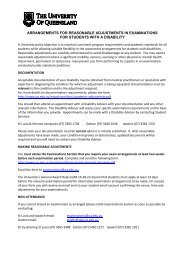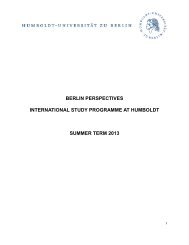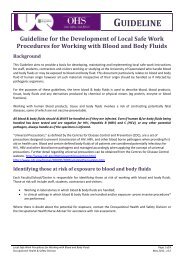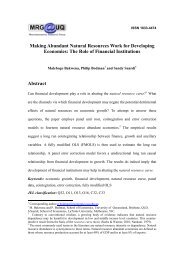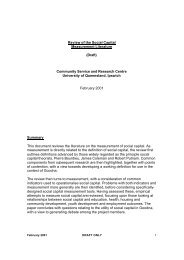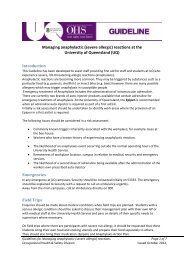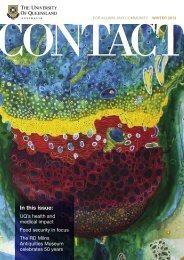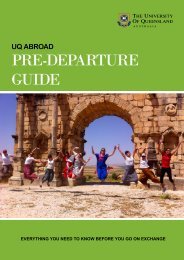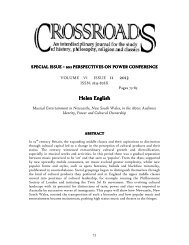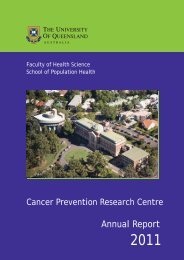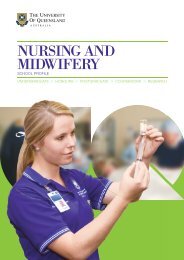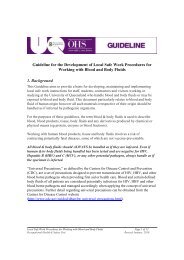Memmott, Paul and Chambers, Catherine - University of Queensland
Memmott, Paul and Chambers, Catherine - University of Queensland
Memmott, Paul and Chambers, Catherine - University of Queensland
Create successful ePaper yourself
Turn your PDF publications into a flip-book with our unique Google optimized e-Paper software.
INTRODUCTIONThis paper reports on some <strong>of</strong> the findings <strong>of</strong> the Inner-City Sydney Aboriginal HomelessResearch Project, which was commissioned by the New South Wales Government'sAboriginal Housing Office (AHO) as a part <strong>of</strong> the Partnership Against Homelessnessinitiative that was established to “co-ordinate <strong>and</strong> improve a wide range <strong>of</strong> housing <strong>and</strong>support services for homeless people" (NSW, Dept <strong>of</strong> Housing, 2002). The brief portraitprovided here <strong>of</strong> the Aboriginal homeless <strong>of</strong> inner-city Sydney <strong>and</strong> the factors that haveinfluenced their situation draws on a consultation report prepared by the authors <strong>and</strong> theircolleagues at the culmination <strong>of</strong> this project (<strong>Memmott</strong>, <strong>Chambers</strong>, Pitts, Green & Ingram2005). It also builds on previous research on Australian Indigenous homelessnessconducted by the authors <strong>and</strong> other colleagues, which has sought to develop aclassification <strong>of</strong> types <strong>of</strong> Indigenous homelessness <strong>and</strong> evaluate the success <strong>of</strong> a range <strong>of</strong>service responses to the issue.Small groups <strong>of</strong> Indigenous people living in public places continue to be a significantsource <strong>of</strong> conflict in many urban centres around Australia. <strong>Memmott</strong>’s research intoaspects <strong>of</strong> Indigenous homelessness began in the early to mid 1990s, firstly in AliceSprings among its informal river campers, <strong>and</strong> then with Aboriginal visitors to the HallsCreek community (<strong>Memmott</strong> 1990, 1991A & B, 1993). More recently, an intense researchproject was carried out for a partnership <strong>of</strong> cross-jurisdictional government <strong>and</strong> Aboriginalagencies in the Northern Territory on the Aboriginal public place dwellers (or ‘LongGrassers’) <strong>of</strong> the Darwin area <strong>and</strong> a strategic review undertaken <strong>of</strong> program responses totheir itinerant lifestyles (<strong>Memmott</strong> & Fantin 2001), part <strong>of</strong> which involved a limitedliterature analysis <strong>of</strong> the subject. Following this in 2002 the Commonwealth Department<strong>of</strong> Families <strong>and</strong> Community Services provided a small grant to complete a nationaloverview <strong>of</strong> response strategies to Indigenous homelessness (<strong>Memmott</strong>, Long &<strong>Chambers</strong> 2003). The aim was to canvas a wide repertoire <strong>of</strong> techniques <strong>and</strong> approachesin order to raise awareness as well as provoke debate among service providers <strong>and</strong> policymakers. Through 2003 <strong>and</strong> 2004 a number <strong>of</strong> papers were prepared with funding from theAustralian Housing <strong>and</strong> Urban Research Institute, the focus <strong>of</strong> which was to develop a list<strong>of</strong> categories <strong>of</strong> Indigenous homelessness based on identified needs <strong>and</strong> assess how anaccurate typology should inform improved service provision. It also included an overview<strong>of</strong> government policy with regards homelessness (<strong>Memmott</strong>, Long, <strong>Chambers</strong> & Spring2003). This categorisation has informed the work discussed here <strong>and</strong> is summarised in thefollowing Table.TABLE 1: CATEGORIES OF INDIGENOUS ‘HOMELESS’ PEOPLENote: These are not mutually exclusive categories. (Adapted from <strong>Memmott</strong> et al 2004: Table 2.1.)1. PUBLIC PLACE DWELLERS. Living in a mix <strong>of</strong> public or semi-public places (as well assome private places, which are entered illegally for overnightshelter) eg parks, churches, ver<strong>and</strong>ahs, carparks, car salesyards (under cars), beaches, drains, riverbanks, vacant lots,dilapidated buildings.1.1 Public place dwellers – voluntary, short-termintermittent.1.2 Public place dwellers – voluntary, mediumterm.These people are <strong>of</strong>ten staying in conventionalaccommodation (eg a relative’s house) <strong>and</strong> may have theirown residence in a rural or remote settlement. When theysocialise in public urban places, they may or may not decideto camp out overnight, usually with others, despite theavailability <strong>of</strong> accommodation.Residing continually in public places (including overnight);acknowledge they have another place <strong>of</strong> residence in a homecommunity but uncertain if <strong>and</strong> when they will return.Homelessness Amongst Aboriginal People in Inner Sydney Page 1




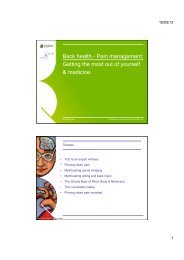
![Recycling [ PDF, 62KB ] - University of Queensland](https://img.yumpu.com/51805185/1/184x260/recycling-pdf-62kb-university-of-queensland.jpg?quality=85)
